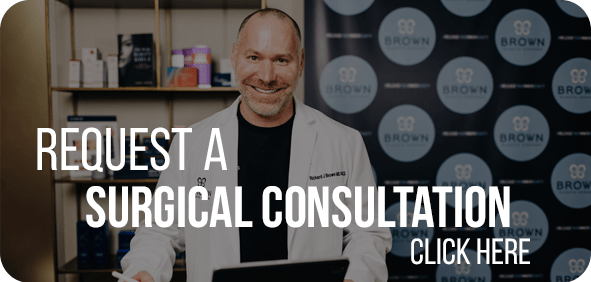Will My Arm Lift Scar?
Here at the offices of Dr. Richard J. Brown, board certified plastic surgeon, we often hear concerns from patients considering an arm lift that the resulting scar may be very prominent.
The short answer: Yes. Like all surgeries, an arm lift will result in scarring to some extent. However, the degree of scarring depends on each patient’s genetic makeup and predisposition to scarring, and there are methods of minimizing your arm lift scar following your surgery.
Related: Am I an Arm Lift Candidate?
An arm lift, or brachioplasty, is a procedure used to remove excess skin from the upper arms. This is often done after a patient has had significant weight loss and wishes to remove the “wings” of skin that are left behind. The length of the incision varies by patient, but may range from a few inches near the armpit to the entire length of the upper arm between the armpit and the elbow. Usually the scar will be located on the underside of the arm or on the back of the arm.
The main factor in visible scarring is tension on the wound. Incisions that are under more tension tend to scar more visibly. Following your surgery, Dr. Brown will take several precautions to minimize scarring.
Close in Layers
Closing the incision in multiple layers relieves some of the pressure throughout the incision. This prevents pulling and minimizes puckering as different layers of skin heal at different rates.
Use Pressure
After your surgery, you will be given compression sleeves to wear for the first few weeks. These garments help reduce swelling by keeping your arm in a confined space. If left unchecked, the normal swelling that occurs post-op might put undue tension on your incision, thus worsening the scar. Dr. Brown usually instructs patients to wear the garment for four to six weeks, or until instructed otherwise.
Treat Accordingly
Silicone-based scar treatments applied to your incision help minimize the appearance of scarring. Silicone scar sheeting generally works best, though silicone gels are also effective. Dr. Brown and his staff can answer any other questions you may have about scar treatments.
It is also important to protect your scar from sunlight for the first year following surgery. Use a minimum SPF 30, even if covered with clothing. Exposure to UV rays can sometimes discolor scar tissue, making it more visible.
To learn more about brachioplasty or to schedule a consultation with Dr. Richard J. Brown, give us a call at 480-568-3804



